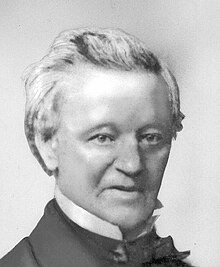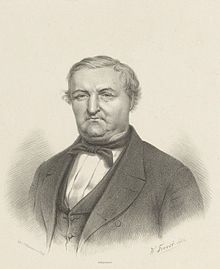|
Brothers Halbertsma
   The Brothers Halbertsma were three brothers born in the Frisian village of Grou towards the end of the 18th century, who played a role of crucial importance for the development of a written literature in the Western Frisian language.[1][2][3] These three brothers were:
Apart from these three writers, who are usually meant when speaking of the 'Brothers Halbertsma', there was a fourth brother, who did not produce any literary work:
The Brothers Halbertsma were all born in the house of their parents on Kowemerk ("Cow Market") street in Grou, a village in the central part of the Dutch province of Friesland.[17] They were sons of the baker and small-time merchant[1][18][17] Hidde Joasts Halbertsma (1756–1809)[1][19] and his wife Ruerdtsje (or Riurtk)[17] Tsjallings Binnerts (1767–1809).[1][19][20] Two children who were born later died in early childhood,[21] the little boy in 1803,[17] and the little girl in 1805.[17] Justus, Tsjalling and Eeltsje were much like their father, while Binnert more resembled their mother.[1] Ruerdtsje Binnerts was a scion of a prominent family in Grou.[1][18] Her people were Mennonites,[1][18] and although her husband had been raised a Calvinist, he converted after marrying her.[1] From Justus' letters Ruerdtsje emerges as a smart businesswoman,[1] a loving mother, and a deeply religious person.[22] About Hidde Halbertsma, the father, much less is known. It is thought that he might have been a mariner before his marriage.[22] He is described as a gentle soul, who was, however, apt to take offence, and could be quite sharp-tongued in such cases.[22] In 1784, he published a long Dutch-language poem under the title Schrikkelijke IJsgang en Overstroominge in Gelderland ("Terrible Ice-drift and Flooding in Gelderland").[22] From this intriguing work it is clear that his sons' literary talents were a family trait.[22] The Brothers Halbertsma were very close, possibly as a consequence of the fact that both their parents died at a relatively young age in 1809, when Justus was just twenty years of age, Tsjalling seventeen, Binnert thirteen, and Eeltsje only eleven.[18][19][23] Later, Justus and Eeltsje started to write short fiction and poetry which can be considered folk literature.[24] As Justus acted as editor for Eeltsje's work for his entire life, their poetry and prose were strongly connected from the very beginning and for the most part published together.[25] For that reason the linguist Foeke Buitenrust Hettema would later describe Halbertsma as the 'literary agent' of his brothers Eeltsje and Tsjalling.[24] In 1822, Justus and Eeltsje's early works were collected under the title De Lapekoer fan Gabe Skroar ("Gabe Tailor's Rag Basket"), a booklet consisting of 36 pages, and including six poems and one short story.[26] This publication was attributed to the fictional 'Gabe Skroar', a lame farmer's son who became a tailor and a writer, but died young.[27][28] This character was in all probability a creation of Eeltsje's.[27] Hiding behind such a fictional author was fairly normal at that time.[27][28] A second, expanded edition of De Lapekoer fan Gabe Skroar, consisting of 237 pages, was published in 1829, followed by a third, further expanded edition in 1834, running to almost 500 pages of a larger size.[26][29][30][31] After that, additions were published separately in 1836 (De Noarger Rún oan Gabe Skroar), 1840 (Twigen út in Alde Stamme), 1854 (Leed en Wille en de Flotgerzen), and 1858 (De Jonkerboer and Teltsjes fan de Wize Mannen fan Esonstêd).[26][32] Eventually, contributions by the third brother, Tsjalling, were also inserted.[9] After the death of all three Brothers Halbertsma, their short fiction and poetry was gathered under the supervision of librarian and archivist Gerben Colmjon and bookseller and historian Wopke Eekhoff.[33][34] In 1871, it was published by the firm of J. de Lange in Deventer, under the title of Rimen en Teltsjes ("Rhymes and Tales").[35][26][18][29][34] This work is now thought of as the national book of Western Frisian literature,[26] and although the literary value of this collection was later disputed by some critics,[36] it is undeniable that Rimen en Teltsjes and its predecessor De Lapekoer fan Gabe Skroar played a role of crucial importance in the development of a new literary tradition after Frisian had been used almost exclusively as a spoken language for three centuries.[26][3][37] In 1949, author and literary critic Anne Wadman wrote that the Halbertsmas gave "the Western Frisian people a literary monument, in which it saw its own life as a nation [...] reflected."[38] As of today Rimen en Teltsjes still occupies the first slot in the ranking of Western Frisian literary classics.[3] References
Sources
|